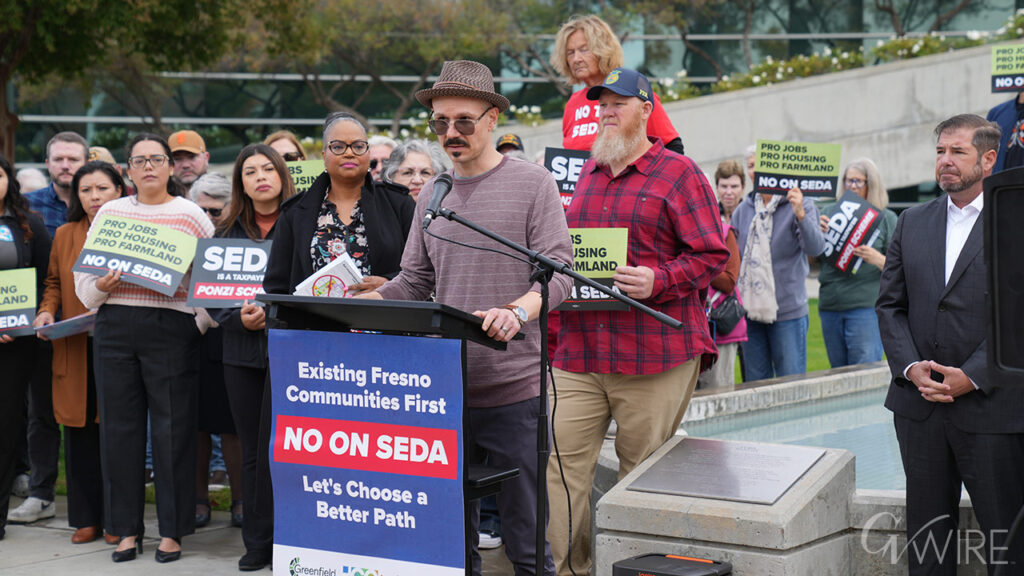Share
|
Getting your Trinity Audio player ready...
|
Floodwaters from an overflowing Lake Success reached the Tule River next to Joseph Goni’s Tulare family dairy on March 15, in the middle of the night, much faster than he had expected.

Nicole Foy
CalMatters
When Goni and his fiancee woke up, the water was at their front door. By the time his sister and brother-in-law, who also lived on the farm, pulled their children out of their home in pajamas, 2 to 3 feet of water was rushing everywhere, impossible to stop.
Goni choked up recently as he and Roberto Martinez, a 30-year employee, recounted how floodwaters nearly washed away the dairy three generations of his family had built.
“It started with us,” Goni said of the gushing water. “Then we started hearing about it moving toward Corcoran. And it was just one dairy after the other, after the other.”
Over 72 hours, Goni, Martinez and dozens of neighbors and livestock haulers who arrived with trucks and trailers frantically herded some 2,400 cows and heifers into trailers in the dark. Even with weeks of planning, moving a few hundred head would have been difficult; moving this many in flood waters was a nightmare, the men said.
The cows went to six area dairies that were on safer ground, and Goni said he was overwhelmed by his community’s support. Goni remembers joking he would understand if workers left.
“We have to fight,” Martinez said, adding that Goni’s father, who died last year, would have wanted them to. “We can’t lose everything because of this week.”
Thousands of San Joaquin Valley farmers, workers, and residents are coping with acres of floodwaters and muck, tallying the damage. One industry official estimated $20 billion in losses for dairy, California’s No. 1 agricultural industry, generating $7 billion in revenue statewide.
Some who lost homes also fear losing weeks or months of income. After months of atmospheric rivers, storms, and record floods, the long-dry Tulare Lake is rising again from the San Joaquin Valley floor. It will be fed, experts said, by a historic snowpack melting in the Sierra Nevada.
Will California be ready?

So far, the track record for state and local emergency response has been mixed, especially in the San Joaquin Valley, where local agencies have struggled to mediate conflicts between landowners and flooded communities, and where state officials have yet to clarify their oversight role.
Farmers, workers, and residents in several flooded communities complained that it took weeks for the state to gain federal help through a disaster designation. Even with that, many farmworkers won’t qualify for federal cash assistance because they are undocumented.
But Gov. Gavin Newsom’s office said some people could receive help through local partnerships using the state’s Rapid Response Fund. The state has not announced which local partners it was funding.
State officials said they are bolstering infrastructure, such as levees and canals, and raising some roads while coordinating with agencies to help people cope with floods and prepare for possible evacuations.
Brian Ferguson, a spokesperson for the Governor’s Office of Emergency Services, said state officials have been meeting with emergency managers for each affected region, coordinating area-specific evacuation plans and flood prevention measures, trying to get everyone on the same page.
“We’re paying particular attention to the Tulare basin because there’s already so much water in the system and that’s where the snowpack is really concentrated,” he said. “Humans, in many cases, are the hardest part of any disaster to control.”
Some of the country’s biggest farms operate in this region. Tulare, Kern, and Kings counties are top-producing dairy counties in the state.
The Tulare Lake basin’s vast farmland had suffered a severe drought, like most of California. Now floodwaters envelope it, looking like an inland sea when winds whip waves over swallowed houses, farms and rural Highway 43.
Nearly all of the four rivers, countless creeks and thousands of miles of canals linked to Tulare Lake are swollen and at capacity. The valley ground has soaked up so much water that every passing rainstorm floods yards and asphalt roads, even in urban centers like Bakersfield and Fresno.

“It’s a very important reminder that California is not well-equipped to handle these extreme wet-weather events,” said Tricia Stever Blattler, executive director of the Tulare County Farm Bureau. “The message that we would like our California Legislature to hear is it’s never too soon to make better investments in infrastructure.”
The Biden administration declared California’s second major disaster of the year on April 3, deploying the Federal Emergency Management Agency and allowing several counties, including Tulare and Kern, to apply for additional federal assistance. Because of the declaration, families and residents in seven counties can apply for Disaster CalFresh food benefits, the state announced Friday.
Billions of Dollars in Losses
Though Kings County had 47,000 acres of farmland flooded, according to the California Farm Bureau’s online publication, that county was not included in the latest emergency declaration. State officials said it could be added later. Kings County officials told the Fresno Bee flooding will ruin 41% of the county’s $2.43 billion crop value and cause another $1 billion in damages.
In California’s request for the declaration, Newsom’s office estimated $60 million in agricultural losses in Tulare County and $70 million in Kern County.
California dairy industry leaders say their losses are going to be much larger. Western United Dairies CEO Anja Raudabaugh said their network is bracing for $20 billion in losses and long-term supply chain disruptions.
In addition to evacuation costs and property damage, dairy farmers are estimating millions of dollars in losses from the silage they had stored and crops they were growing to feed their cows.
If there is not enough feed, she said, farmers might have to start culling cows and shrinking their dairy operations.
“This was an unmitigated disaster. I don’t know how to plan for a river. It’s a nightmare.”
ANJA RAUDABAUGH, Western United Dairies CEO
Already 75,000 cows and 15 large dairies have moved due to flooding. With major dairy processing centers like Tulare County impacted, the economic loss could be staggering, Raudabaugh said.
“There’s not a single dairy that could have envisioned this type of catastrophe,” she said. “This was an unmitigated disaster. I don’t know how to plan for a river. It’s a nightmare.”
Add to that the brief closure of the Lactalis Heritage Dairy Kraft Foods plant, which processes some of the Tulare region’s dairy products. Its damage and flood waters were visible from Highway 99.
More than half of California’s farmworkers, about 200,000, live in the Central Valley. Thousands are losing work and wages. Several towns and rural communities of color also are struggling.
“The reality is the Central Valley has a lot of frontline communities that have borne the impacts of climate and weather extremes, whether it’s drought, smoke, flood,” said John Abatzoglou, climatology professor at the University of California, Merced. “Unfortunately, they have not had the resources to prepare for these extreme events, and that’s why they’re vulnerable.”
Preparing for Snowmelt and ‘Water Jiu Jitsu’
Several regions could experience higher-than-usual flood risk from snowmelt, experts said, but the Tulare Basin’s reservoirs are smaller than the central and northern Sierra reservoirs so they hold much less water, Abatzoglou said. It’s an unfortunate mismatch with the high snowpack in the southern Sierra.
Despite intermittent flooding over the years, the region’s levees, canals and dams may not be able to handle such large and rapid water flows, experts said. Floodwaters in some areas are not sinking into the ground, recharging underground water stores.
“We just don’t have the systems in play to put water in places where you can really get a lot of groundwater recharge while minimizing the impacts to communities and agriculture,” Abatzoglou said.
“I think a year like this, hopefully, will be a catalyst for the state to find ways to be more resilient to climate variability and the extremes of climate change — because this is not likely to be the last rodeo that we’re gonna go through.”
Ferguson, the state emergency services spokesperson, said the current break in storms is giving emergency management officials a rare chance to prepare for the possible coming disaster.
They are assessing potential toxic hazards from agricultural or oil sites in the flood path, he said, so they can prevent contaminating nearby farmland or waterways. For example, officials may build a dam around a waste treatment plant run by the Los Angeles County Sanitation Districts in Kings County, according to a KVPR news report.
They’re also reaching out to underserved communities to help people access emergency information in their native languages.
And state officials are working with local water managers and county emergency personnel, planning for worst-case scenarios, he said.
“It may be that this water is not such that there are enough sandbags, or you can’t physically stop it,” Ferguson said. “You might be doing water jiu jitsu to move it, to flow with it, as opposed to trying to physically stop it … to move it in the smartest possible way to keep as many people safe as possible.”
That may involve finagling a compromise from local agencies and land owners who have been working at cross purposes. In Kings, Kern and Tulare counties decisions about handling flood waters have devolved into local tugs-of-war, with individual farmers influencing where waters go.
“We don’t want the money. We just want the canal fixed. We’re afraid it’s going to happen again.”
Juanita Martinez, cutler resident whose home flooded
In a local conflict that made national headlines, the historic Black town of Allensworth, nearby Alpaugh, and farmers along the Tulare Lake bed were flooded after a large landowner refused to allow his property to flood. As Allensworth residents pleaded for official intervention and scrambled to save their community, SJV Water, a nonprofit newsroom, reported that the landowner had placed heavy farming equipment in the way of a water manager’s efforts to use the farmer’s private canal.
The creek recently burst into the canal anyway, after it also overflowed a bridge and road.
State officials have been coordinating with local emergency forces to shore up levees and distribute sandbags.
Although state officials are exploring options for taking a more active role in managing flood waters, local authorities have the jurisdiction to determine where floodwaters go, said Karla Nemeth, director of the Department of Water Resources.
Several communities in southern San Joaquin Valley had opted out of the Central Valley Flood Protection Plan, so the ultimate authority over where water goes — and whose property floods — can reside with county officials, small flood districts, and even individual property owners.
“At the moment all of those issues need to be addressed at the local level,” Nemeth said. “We are checking into our state authorities on flood management kinds of decisions.”
The governor’s office recently issued an executive order that temporarily waives several state codes related to environmental protections around the Tulare Lake basin. But the order doesn’t allow state officials to step in and arbitrate these conflicts, a governor’s spokesperson said.
Dairies Stay on High Alert
The Goni family has begun rebuilding their dairy. Their employees and cows are back and production is slowly restarting.
Not everyone has been able to recover. Some dairies and farmland in the Corcoran area still are covered with water. Raudabaugh said two large dairies have closed or relocated.
Flood Control Is Lacking
Coordination among local and state emergency resources has improved since those first two weeks, when industry leaders were fielding panicked calls from farmers, Raudabaugh said. She said she hopes they’ll be ready for the next round of flooding when the snowpack melts.
Stephen Mancebo, a relative of Goni’s whose dairy is a few miles down the road, was among those who rushed to help Goni and hosted some of his cows. He said the lack of infrastructure exacerbated the disaster.
“If we could have put more water storage in place, bigger and better infrastructure, more sinking basins, when we got this flood it wouldn’t have been near as bad to those guys on the west side,” said Mancebo, a board member of the Land O’ Lakes dairy co-op.
“We’ve avoided putting money into infrastructure. And I know the governor and nobody else wants to hear that, because they really like showing up to be the hero, and it’s more reactive than proactive.”
Mancebo had to make other quick decisions that week. The canal linked to Lake Kaweah crossing his property began overflowing into fields where he grew winter wheat for his dairy.
Many farmers and residents, rushing to protect their property, built berms to keep the water out. He knew if he did that, too, the water would have flooded another dairy down the road and some neighboring homes. His dairy was safe on higher ground, but he didn’t try to stop the water from flooding his fields.
Standing on the banks of the Tule River and later the ditch outside his own dairy in late March, Mancebo pointed out where the river burst through the levee protecting Goni’s dairy and had ripped out large metal drainage pipes, and where water had flooded his own fields, leaving a layer of silt and debris.
Debris could clog the canal where it flows under the road, he said, and could cause flooding risks over the next few months.
“Everybody is just going to have to stay on high alert,“ he said.
A “domino effect” of damage to dairies and farmers has already begun, he said, with owners laying off workers because they have no work for them.
“That’s why I have a really hard time talking about this or feeling sorry for a couple hundred acres, you know?” Mancebo said.
Getting financial help to farm laborers could be a challenge. Dairies employ higher numbers of undocumented workers than other agricultural industries, which hire workers from a federal visa program for seasonal workers. Dairies operate year-round.
‘We Couldn’t Save Anything’
Small communities in the Central Valley, especially on the eastern edge of Tulare County near the mountains, have flooded repeatedly this year.
In Cutler and Orosi, two towns in the foothills of the Sierra Nevada, more than 131 homes flooded in mid-March, after water breached an overwhelmed canal in eight places and left many homes uninhabitable.
Weeks after his home in Cutler flooded, Victor Cabrera said he still didn’t have heat or hot water. He was able to use a space heater by running an electrical cord from a neighbor’s house on higher ground.
The house next to Cabrera sustained so much damage it was condemned, and his neighbors were forced to relocate, he said.
“It’s been rough on us,” Cabrera said, referring to his neighborhood.
Many of the hardest-hit families in Cutler lived in the Tulare County Housing Authority homes near a flooded canal. Residents pleaded for help at a recent Tulare County Board of Supervisors meeting, saying the destruction left behind was unsafe for children.
Juanita Martinez cried during her testimony, saying her 9-year-old son fears the canal would break again if they return home.
“We couldn’t save anything,” she said during the meeting. “I’m in tears. I’m frustrated. I don’t know what to do anymore.”
The housing authority transferred Martinez’s family to a home in Dinuba, but she told CalMatters her application for federal disaster aid was rejected. Many families who don’t qualify for aid still need help, she said; plus, who is going to fix the canal?
“We don’t want the money,” Martinez said. “We just want the canal fixed. We’re afraid it’s going to happen again.”
About the Author
Nicole Foy is the Central Valley reporter for the California Divide team. She returned home to the Central Valley in 2022 after several years as an investigative reporter in Texas and Idaho, focusing on Latino communities, agriculture and inequity. While in Idaho, she was a 2020 Community Impact Fellow for Stanford University’s John S. Knight Journalism Fellowship program, leading a bilingual COVID-19 reporting collaborative. She graduated from Biola University and is the co-founder of Voces Internship of Idaho, which places Idaho Latino students in paid newsroom internships.
Make Your Voice Heard
GV Wire encourages vigorous debate from people and organizations on local, state, and national issues. Submit your op-ed to rreed@gvwire.com for consideration.



















